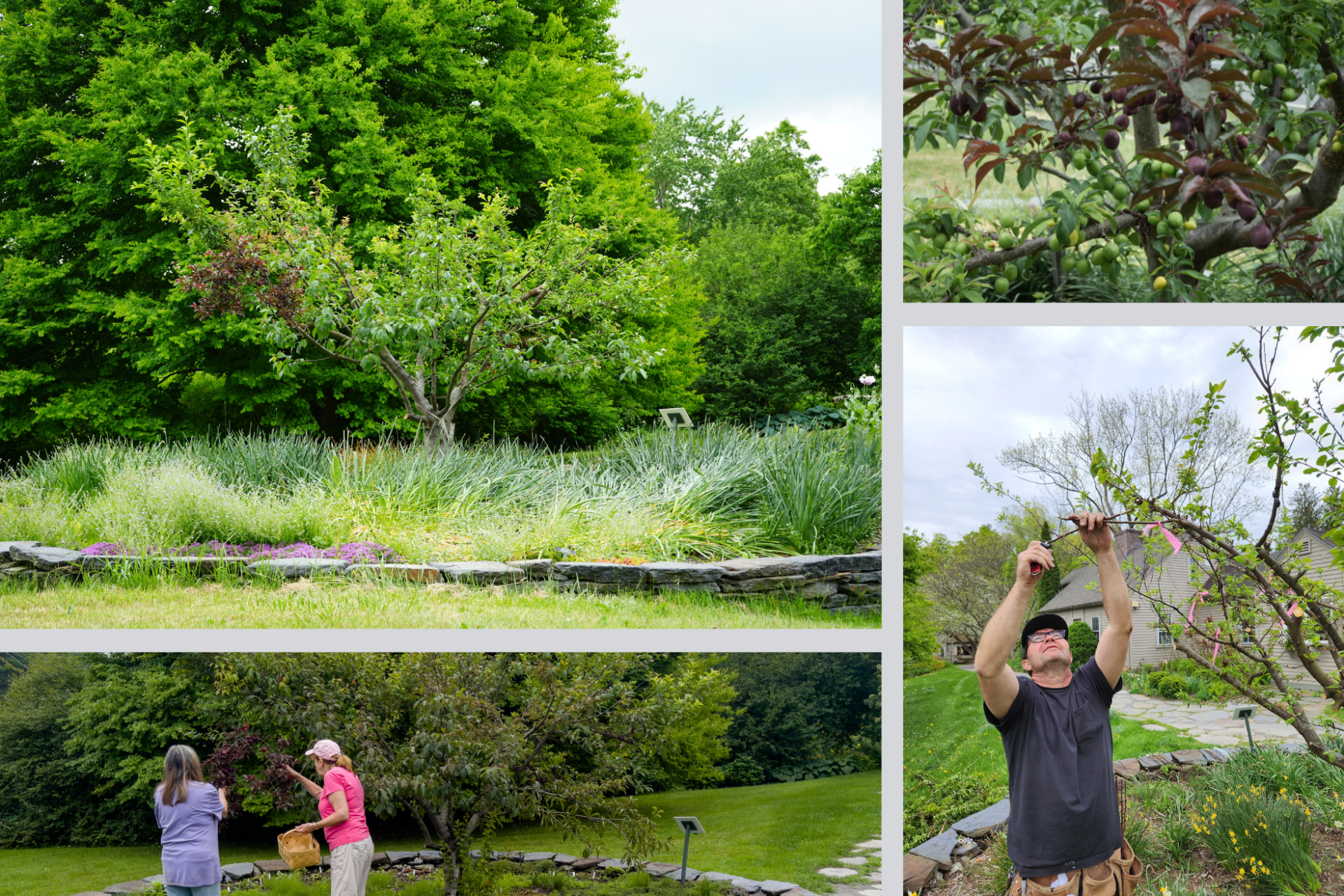You are here
Tree of Forty Fruit
Tree of Forty Fruit
Our Tree of Forty Fruit, framed within a circular rock wall beside the Visitor Center, is part art piece, part conservation project. In a riot of pink, white and crimson, it blooms heavily in spring and summer to become what it was created to be: a fruity little Frankenstein, a Swiss Army Knife for stone fruit enthusiasts.
Planted in 2018, the tree is one of a dozen or so around the country. Their mastermind, Sam Van Aken, an arts professor at Syracuse University, hatched the idea about 15 years ago, beginning with a tree he planted on the Syracuse campus. A fan of good-natured hoaxes and hijinks, Van Aken had originally intended merely to engage in a bit of play and mischief: to create, through grafting, a tree that would appear normal most of the year until its multicolored blossoms heralded something more unusual: a fruit tree that bore various fruits, including varieties of apricots, cherries, nectarines, peaches, and plums.
Along the way, he realized his project held greater significance. Reading “The Plums of New York,” first published in 1911, he was inspired to include rare fruits strikingly distinct from the few mainstays found in modern supermarkets. Working with farmers mostly in the Northeast, along with the United States Department of Agriculture, he has stockpiled antique and heirloom varieties to reintroduce species of fruit where they once were grown. His stockpile comes in the form of scion wood, branches from a parent tree that are then used to graft onto another tree in order to propagate that variety.
How did he settle on the number 40? “It’s a number used throughout Western religion — you know, 40 days and 40 nights — to represent something that’s not infinite but that means a multitude,” he explained. Plus, 40 is “manageable,” he said. Pulling a tear-drop travel trailer and hauling the tools of his singular trade, he makes routine visits to his many trees to prune and add grafts. After several years, a tree could hold up to 55 to 60 grafts, he explained. “Then, depending on how they grow, I’ll prune it out until we get 40 solid grafts.”
Raised on a farm in Pennsylvania, Van Aken said the first time he witnessed grafting, he was amazed. Turns out, his great grandfather, a German immigrant by the name of Irving Delp, had made a name for himself as a grafting expert who worked in orchards across Pennsylvania.
“In farming communities, there weren’t many things that impressed people, because, you know, farmers are kind of like jacks of all trades,” said Van Aken. “But whenever people mentioned my great grandfather’s name, they talked about him as if he had this mystical capability, which I always thought was amazing.”
Berkshire Botanical Garden’s tree was funded by Trustee Joanne Cassullo, who was inspired when she learned of one such tree Van Aken had planted at her alma mater, Roanoke College, in Salem, Va. Our tree, like the others, was planted with about 20 fruit varieties grafted to it. As the tree matures, Van Aken continues to graft more varieties each year, though that process was interrupted for one year on account of the vole colony that had caused deep damage to the tree’s trunk. After Van Aken made an emergency visit in the spring of 2023 to apply some creative triage in the form of grafting root sprouts back into its trunk, the tree spent a year in intensive care mode — meaning, no grafting — to see if it would survive.
When notified in the spring of 2024 that not only had the tree survived the winter but that it had blossomed for the first time, Van Aken said, “Well, this is fantastic. It’s working!”
The tree now supports about 36 varieties of stone fruit — that is, fruit with pits — including yellow and white peaches, European and Asian plums, and several apricot and cherry varieties, each representing a rich and vast piece of the region’s agricultural history. The tree includes a variety of plum, the Damson plum, that dates back 2,000 years, Van Aken said. “It originated in Damascus,” he said. “It was brought into Europe during the Crusades and naturalized. Due to its hardiness, it was one of the first European plums grown in the Americas.”
When word got out in late spring about the fruit taking form on this veritable arboreal amusement park, the intrepid kitchen crew of our Herb Associates, which oversees our display garden and production garden, made a beeline. They harvested some of its fruits over the span of several weeks to make tasty chutney and jam (sold in jars in the Visitor Center’s Gift Shop).
“Taste this,” said Theresa Terry of the Herb Associates on a beautiful July day, holding out a mixing bowl with the remnants of fresh Tree of Forty Fruit plum chutney in the Center House kitchen. “You’ve got to taste this. Yum!”
Help Our Garden Grow!
Your donation helps us to educate and inspire visitors of all ages on the art and science of gardening and the preservation of our environment.
All donations are 100 percent tax deductible.


